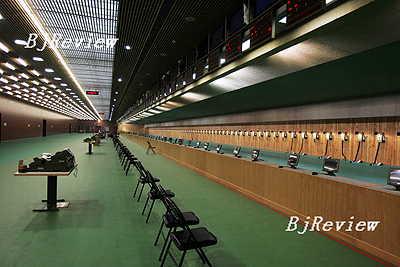
A gold key to the Beijing Shooting Range Hall was handed to the Shooting Center of the General Administration of Sport of China on July 28 in the morning, symbolizing the official delivery of the first venue for the Beijing 2008 Olympic Games. The new Shunyi Olympic Rowing-Canoeing Park became the second completed venue as it was officially delivered later the same morning.
The official completion of the two venues sends a signal that China's run-up to the 2008 Olympic Games has come into its final stage just one year ahead of the opening ceremony. According to a Xinhua report, out of the 31 Olympic stadiums in Beijing, 23 will be completed by the end of September.
Located in Shijingshan District in western Beijing, the Beijing Shooting Range Hall will host all of the 10 Olympic shooting events.
Construction of the venue broke ground on July 13, 2004. With a total surface area of 45,645 square meters, the stadium has seating capacity for 8,600 spectators, with 2,170 permanent seats and 6,430 removable seats.
Both the qualification competition hall and the final competition hall contain 10 meter, 25 meter, and 50 meter target ranges. The qualification competition hall can seat 6,100 people, and the final competition hall can seat 2,500.
After the Games, the venue will host important international and Chinese shooting competitions and serve as the training base for the Chinese national shooting team and youth training grounds.
Parts of the venue might also be used as a national defense teaching facility and to promote shooting as a sport to the public.
The Beijing Olympic rowing and canoeing venue is situated in northeastern Beijing's Shunyi District. Covering 31,850 square meters, it is the largest Beijing Olympic Games venue in terms of surface area. It will host rowing, canoeing, kayaking and marathon swimming events and 32 gold medals will be awarded at the venue. On August 8, the Shunyi Rowing-Canoeing Park will host the 2007 World Rowing Junior Championships, this year's very first "Good Luck Beijing" sport event. The Shunyi Olympic Rowing-Canoeing Park is the world's only first-class rowing-canoeing venue that contains both flatwater and slalom courses.
The park has a seating capacity of 3,700, with 1,200 permanent seats and 2,500 temporary ones. After the Olympic Games, the venue will be converted into a resort for swimming and recreation-the largest of its kind in the northeastern part of Beijing.
Theme stadium
The Beijing Shooting Range Hall was designed to reflect the shape of a hunting bow. The design takes into consideration the origins of the sport in hunting. The Shooting Hall's qualification competition halls and the final competition hall are connected by the venue's main entrance, which contributes to the venue's "bow" shape.
To instill the hunting theme into every detail of the stadium, the designer has inserted brown wood-like stripes into the outside walls to create a look reminiscent of a forest, painted the inside walls green and adopted soil-color tiles in the stadium. Even green plants have been placed at the corners of the stadium to radiate the smell of a forest.
To make the stadium essentially green and environmentally friendly, the stadium has adopted a "bio-climate" double curtain wall, which is advanced in China. The curtain wall functions as an environmental filter-a membrane mediating between desired interior conditions and variable exterior circumstances. The curtain wall also encourages the use of fresh air and natural daylight, while at the same time aiming to improve user comfort, reduce energy consumption, and promote a "sustainable" lifestyle. It will greatly reduce the cost of heating and cooling the venue.
While the stadium was designed to be China's largest shooting stadium in terms of the number of targets, the construction site was located in an area banned by Beijing Municipal Government for any building higher than 18 meters. Thus the architecture used a two-story structure, with shooting ranges on both floors, which posed a challenge to the quakeproof quality of the building. To meet the challenge, the designers introduced a large pre-stressed hollow core slab.
According to the chief architect of the building, Zhuang Weimin, President of the Architectural Design and Research Institute of Tsinghua University, Olegario Vázquez Raña, President of the International Shooting Sport Federation, hopped and leapt on the second floor as a joke test of how quakeproof it was during an inspection visit, and was satisfied with the result. | 